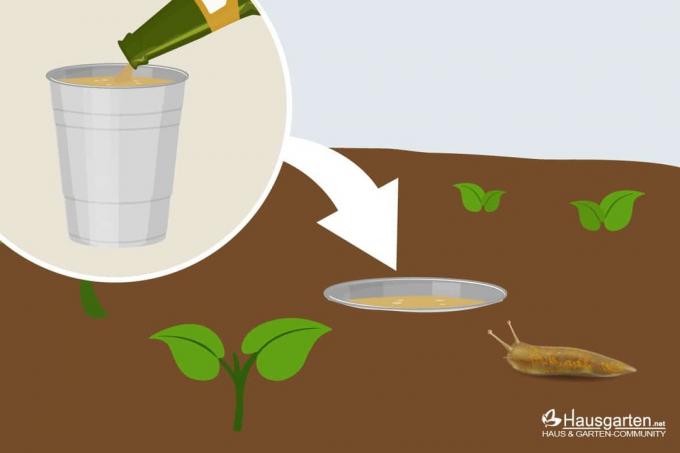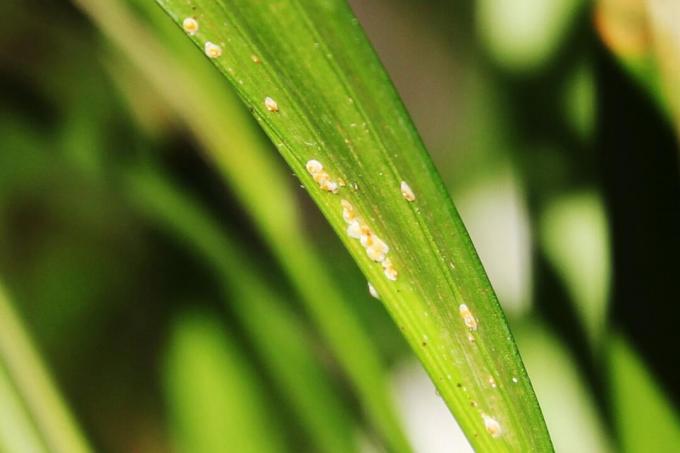

Table of contents
- The harmful picture in mealybugs
- Combat mealybugs biologically
- Supplemental chemical agents
- Worth knowing about mealybugs and mealybugs shortly
- Endangered Plants
Most mealybug species prefer herbaceous plants, especially grasses, daisy family and legumes. The insects can quickly become a nuisance and should therefore be collected or combated with special solutions.
The harmful picture in mealybugs
The first thing you usually recognize is the cotton-like white webs on your plants, which are reminiscent of small fluff. These are frayed wax scales or a web of wax that insects use to protect themselves from predators. The animals are oval in shape and mostly between 3 and 7 mm in size, but can get even longer. On the back of the pests you will find characteristic transverse grooves, which divide the individual body segments.
The mealybugs look very similar, but the web looks more like powder and is reminiscent of dust. The animals can be found especially on the axes and branches of plants or on the undersides of leaves. Special species also attach themselves to roots and are visible either on the individual roots or on the walls of the planter. The animals bite into the plant parts and damage plants by depriving them of the plant sap, which is important for transporting nutrients. In addition, the insects excrete honeydew, which attracts or destroys fungi. which can lead to the transmission of infections. Affected leaves can turn yellow, shoots wither and the growth of the entire plant is stunted. The honeydew can be discolored black as a result of fungal colonization. Mallows, hydrangeas, boxwood or ivy are often attacked outdoors. At
indoor plants mostly herbaceous plants are affected, such as succulents, orchids, but also palm trees and cacti.Combat mealybugs biologically
An important measure for the prevention of insects and scale insects is the regular control of the plants. Infested plants should be separated from plants that are still healthy to prevent the rapidly multiplying insects from spreading. The pests are usually introduced through new purchases, so it can generally make sense to separate newly acquired plants to test whether they are infested with mealybugs. Individual animals can be collected, for example with a cotton swab. Another way to combat it is with oil preparations. Rapeseed oil in particular is often well tolerated by plants. Soft soap, mixtures with washing-up liquid or alcohol (e.g. B. Diluting 15 grams of soap with alcohol and dissolving it in about a liter of water) as well as brandy and vodka can get rid of uninvited guests. It is important to note the following:
- Individual affected areas can be treated with a cotton swab soaked in the solution. Use it to wipe the leaves and especially their undersides thoroughly. Oil and alcohol will soften the insects' skin, killing them.
- You can also use neem oil. The extract of the Indian neem tree encloses the insects so that they suffocate under the oil.
- Instead of rubbing the parts of the plant individually with the solution, you can hose them down completely with the mixture.
- Check the compatibility of the agent on a branch in advance and observe in the following days whether irritations occur. Many orchids, for example, do not tolerate oils.
- Make sure you hit the mealybugs and mealybugs directly. The plant should be watered well so that the solution drips off the leaves.
- When treating with oil, the plants should not be placed in direct sunlight, otherwise burns may occur.
- If you use washing-up liquid, you should use the solution again after allowing it to act for at least 10 minutes wipe with clear water or spray the plant with water, because the detergent can damage the pores damage.
- Very heavily infested parts of the plant should be cut off immediately, because there is a high probability that the animals will appear again and again.
- Then put the plant in new substrate and repeat the process after 14 days to catch any hatched lice afterwards.
For biological control, you can also use beneficial insects that you can purchase in specialist shops. The Australian ladybird, for example, eats mealybugs and thus helps you to get rid of affected plants naturally pestsn to free.
Supplemental chemical agents

Sometimes the pests are so stubborn that home remedies or biological methods are not enough to get rid of the insects. Precisely because the animals can also hide in the substrate or in the ground and from overlooked ones New mealybugs keep hatching from eggs, sometimes chemicals are needed to stop the infestation remove. Appropriate means are, for example, combination sticks, ornamental plant sprays or special substrate means, which you put in the bow. The sticks must be inserted into the root ball. If you have indoor plants in hydroculture, you can alternatively put them in the irrigation water in the planter or in the garden. put coasters. The effect can take a few days. You should apply the sprays from a certain distance (about 30 cm), as they are usually cool and otherwise damage the leaves. Place the affected plants outside to spray and rinse off the dead mealybugs with warm water.
Worth knowing about mealybugs and mealybugs shortly
Mealybugs, also known as mealybugs, belong to the superfamily of scale insects. Mealybugs are plant pests and consequently live there too. They can reach a body size of about 3-6 mm. They also have a special cold-repellent skin that makes them resistant to cold. Temperatures down to minus 40 °C are no problem for mealybugs.
The faster, the better, is the clear motto here, because these small animals are capable of producing up to eight new generations in one year. That's a lot of mealybugs, so don't let it get that far. When you notice the infestation, however, it is usually at a somewhat advanced stage: a mealybug infestation is usually only noticed when a downy covering has formed on or on the surface of the skin. can be seen under the leaves, then the next generation is already developing.
If the tiny creatures infest your indoor plants, it is best to take action immediately.
The following countermeasures are recommended in order:
- All infested plants should be separated immediately from plants that are not yet showing any signs of infestation, so that the mealybugs cannot spread further.
- If you have a mealybug infestation, you should check the growing conditions of the plants, as an infestation indicates that the plants are weak.
- If the infestation is less severe, you could try wiping the mealybugs off the leaves by hand, e.g. B. using an alcohol-soaked cotton swab.
- The addition of paraffin oil or washing-up liquid also helps to dissolve the wax layer on the skin, but unfortunately these treatments usually have to be repeated several times.
- The oil-soap treatment is not suitable for every houseplant, e.g. B. Orchids are said to suffer from this type of control.
- Some mealybug species also infest the roots of the plants, they can be fought by rinsing the roots and planting in new soil.
- If many plants are severely infested, only the use of biological pesticides will probably help.
- The Australian ladybirds "Cryptolaemus montrouzieri" should be particularly suitable. B. at Wabshop24 GmbH www.wabshop24.de can order.
You can prevent infestation with mealybugs or Preventing mealybugs if, when purchasing your houseplants, you are already thinking about whether you offer them really optimal conditions in your home in terms of temperature, lighting and nutrient supply can. If this is not the case, it may be more convenient to find a better fitting one Choosing a houseplant while keeping an eye out for the pest infestation of those in front of you plant to wait.
Endangered Plants
Most mealybug species prefer herbaceous plants, especially grasses, daisy family and legumes. Mealybugs reproduce very quickly, they lay hundreds of eggs, especially when it is a little warmer. The strong propagation then also means that many more plant species are attacked by the mealybugs. These include, for example, sugar cane, grapevines and pineapples, orchids and cacti. The mealybugs also have a great fondness for citrus plants.
Since the animals are very easy to recognize, you can quickly understand which pest has infested the plant. They attach themselves to the plants. The bodies of the females are usually covered with a white, floury excretion. In addition, the mealybugs have a waxy layer or wax strips that cover the body and thus protect against the cold.
What can you do against mealy bugs or mealybugs? Biological control can be carried out with the help of the parasitic wasp or the ladybug, they are the natural enemies of the mealybug. parasitic wasps can be purchased at a garden center or directly from a gardener. The lacewing is also one of the natural enemies of the mealybug.
In winter, a mixture of water and paraffin oil has proven effective in combating it. To do this, put about 10 g of paraffin oil per liter of water in a container and mix these substances with the help of a little washing-up liquid. The washing-up liquid also has the pleasant side effect that it destroys the animal's wax shell. However, this agent is also available as a ready-to-spray mixture in specialist shops.
 garden editorial
garden editorial I write about everything that interests me in my garden.
Learn more about crop protection

Beer trap against snails | Build it yourself or let it be?
There are several ways to banish snails from your garden beds, one of which is the beer trap. The animals smell the yeast contained in the beer and crawl into the trap and are supposed to drown in it. The alcohol in beer is also toxic.

Fight scale insects: 20 home remedies
Scale insects are stubborn and feared pests because they feed on the sap of plants. In addition, they spread rapidly and do not stop at neighboring plants. However, there are various home remedies that you can use to fight the plague.

Build your own snail trap 5 tips for the garden
Snails can cause considerable damage, especially to young plants and new shoots. Building a snail trap yourself can prevent this. But what should be used as bait and how should the snail traps be constructed? We show it here.

Fighting voles in the garden: 14 tips
Controlling voles in the garden can be tedious and frustrating. With the right tools and measures, however, the effort is significantly reduced while the chances of success increase. These can also be biological and gentle so as not to pose a burden on the environment and other animals.

Identify and control clothes moths
Identifying and fighting clothes moths is comparatively easy with the right knowledge. Above all, a nest, eggs or even larvae can be quickly eliminated by appropriate measures. In addition, they can be easily prevented. Our guide shows you how.

Cockroaches in the apartment: where do they come from and what helps?
Cockroaches in the apartment are a horror. The cockroaches are carriers of numerous pathogens and can multiply rapidly within a short period of time. To prevent an infestation, you must know the causes of the settlement or fight the insects.

